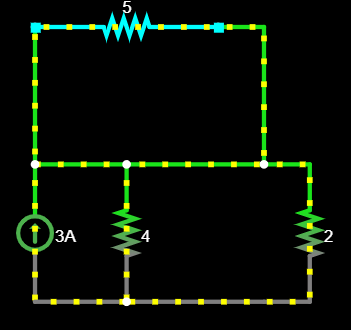"The current flows through path of least resistance" - that statement is not correct.
The correct version would be "the current is distributed proportionally to conductivity" (conductivity is 1/R). So if you have resistors R and 2R, then 2/3 of current will go through R and 1/3 will go through 2R.
So, what does current source exactly do? It generates whatever voltage is necessary to have certain fixed current. So it's immediately obvious that the voltage across 5 Ohm will be zero - both ends of it are attached to constant current output - they're attached to the same voltage. No voltage difference = no current.
So we're left with two resistors, who share full 3A of current proportionally to their conductivity - 2 Ohm will have twice the current of 4 Ohm. 2 Amps across 2 Ohm and 1 Amp across 4 Ohm. 2 Ohm * 2 Amps = 1 Ohm * 4 Amps = 4V across resistors.
It gives us 4V as current source output - which matches ohm's law if we calculate total resistance of parallel resistors. 1/2 + 1/4 = 3/4, thus Rtotal for 2 Ohm and 4 Ohm is 1.333 Ohm. 3 Amps flow through 1.333 Ohm, which means the voltage must be 3*1.333=4V. Perfect match with calculations for individual resistors, means we're correct.
As someone originally from the world of electronics repair, this "path of least resistance" phrase usually was used when talking about short circuits. The point is that short circuit is less than 1 Ohm, and the line without short circuit would have to go through the device it powers and will therefore go through kiloohms of resistance. When difference between resistors is several orders of magnitude, it's fair to say that no current goes through 20k resistance and all goes through 1 Ohm resistance. But it's technically not exactly correct, although in repair world this simplification of situation makes practical sense. As you can see, it's not really how it works and things get more (but not much) difficult when resistances are of comparable magnitudes.


current flows through path of least resistance... so does water ... if you poke two holes in a bucket, will the water flow only through the larger hole? \$\endgroup\$